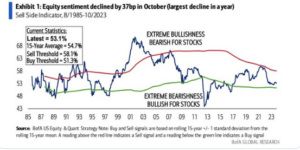“The best way to tell when a trend is going to reverse is when it fills up with a-holes.” – Jared Dillion, author
It’s a rotation of talking heads. The job titles and credentials are impressive…
Head of Quantitative Research
Managing Partner of Equity Research
Director of Emerging Markets Trading
It’s the daily TV parade of Wall Street’s best, predicting what happens next in financial markets. You’ve got to hand it to them; it’s smart-sounding and captivating.
The networks want viewership. The higher the viewership, the more they can charge companies for advertising.
Wall Street wants to generate interest in their financial products. Exposure builds trust, credibility, and might result in a potential client.
It’s a win-win for everyone involved. Except for you, unless you understand the charade is worse than useless.
My wife once asked me if I would ever go on one of these shows.
“They would have zero interest in someone like me.”
“Why not? You’re more than qualified.”
“I couldn’t sit up there and make up some fancy sounding narrative on what happens next. The truth is no one knows what will happen next. The most likely scenario is markets will drift higher, occasionally they will go down, and on rare occasions things will get uncomfortable.”
The truth is the boring, most likely, scenario that doesn’t sell.
However, an astute investor can gather useful information based on how Wall Street is feeling about future stock market prospects.
Enter the Bank of America “sell-side indicator”.
A bearish reading means Wall Street is pessimistic on stocks.
A bullish reading means Wall Street is optimistic on stocks.

Source: Bank of America Global Research
The above chart shows Bank of America’s “sell-side indicator,” a measure of how Wall Street is feeling about U.S. stocks. When the dark blue line is close to the green line, Wall Street isn’t feeling good about future stock returns. Ironically, when Wall Street is this bearish, future stock returns tend to be pretty good (data set 1985 – 2023).
According to Seth Golden, the Wall Street “sell-side indicator” is the most reliable predictor of S&P 500 forward 12-month returns. The current reading is much closer to extreme bearishness, which (ironically) is a buy signal. When the indicator reaches these levels, forward 12-month returns are positive 95% of the time with a median gain of 21%.
How could the smartest people on Earth be the ultimate contrarian indicator?
In my opinion, it’s Wall Street giving the people what they want. Wall Street sentiment tends to mirror the masses.
Is the average investor down in the dumps? Wall Street is too.
Does the average investor think stocks only go up? Wall Street feels the same.
Most investors seek the comfort of knowing what happens next. Wall Street knows this and is playing to human psychology.
Here are few rules to keep in mind if you consume financial media…
- Wall Street is full of credentialed people saying smart-sounding things. In my opinion, these for-profit behemoths are not in the business of client outcomes, rather the business to maximize the bottom line.
- No one knows what will happen next. If they say they do, run the other way.
- Pessimism sells. Everyone loves a good train wreck. The media has figured out that stories that elicit fear tend to sell (see “Retirement Propaganda War“).
- When Wall Street is bearish, an investor might do well to stay the course, put cash to work in equities, or get more aggressive. When Wall Street is optimistic, that could be a time to exercise caution (see “Signs of a Market Bottom“).
Jared Dillion, author of several books and former Wall Street trader, said it best…
“The study of finance is the study of human behavior. The study of emotions. The study of mass psychology. The study of irrationality.”
Have a question? Shoot us a note at insight@pureportfolios.com
